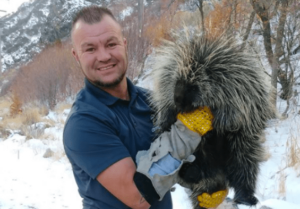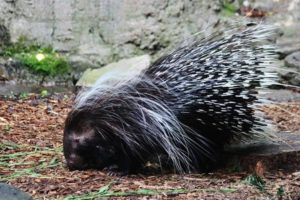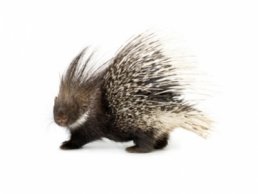Porcupine Removal & Info
Though their name loosely translates to ‘quill pig,’ porcupines are not related to pigs in any way. In fact, porcupines are the second-largest North American rodent after beavers. Their quills are primarily used as a defense mechanism, though, contrary to popular belief, porcupines cannot shoot them at predators. Instead, they lash their tail and embed their quills in the skin of their enemies. Each porcupine has approximately 30,000 quills on its body.
Biology & Behavior
In Utah, porcupines occur throughout the mountains and on woodlands of the state. The porcupine is heavy-bodied, brown to black in color, and has a small head, short legs, and a short, thick tail. Its sharp, barbed quills, 1-1/4 to 4 inches long, cover most of the upper body surface and the tail. Only the face, the under parts of the body and tail are without quills. The quills can be raised and lowered at will but cannot be thrown, although they do come out easy. When disturbed, the porcupine will raise its quills and take a defensive stand. It may whirl or lunge at its opponent, and any attacker will receive a sharp slap from the porcupine’s tail. The barbed quills are driven into the flesh of the attacker, pulling free of the porcupine. The victim’s own movements further embed the quills. This results in intense irritation and even death if the quills that pierce the nose, mouth, tongue, or other areas around the head are not removed. The affected parts may become infected and swollen. Porcupines normally sleep in dens or trees during the daytime and do most of their moving and feeding at night. The ears are small and almost hidden in the fur. Adults weigh 10 to 20 pounds or more and measure 2 to 3 feet long. Porcupines reproduce once a year, giving birth to a single offspring in the spring. On rare occasions, twins are born. For a rodent the 7-month gestation period is unusually long. The young rely on their mother for a very brief period following birth. Excellent climbers, they spend considerable time in trees, especially in winter. In summer, they have been known to travel several miles from the nearest forest to feed in open meadows and fields and along the banks of streams and lakes. The porcupine makes its den in hollow trees or logs, crevices of rocky ledges, or beneath buildings, if it can gain access. Signs of porcupines are fairly easy to detect. In snow, they leave a trough-like trail about 10 inches wide. In soft soil or mud their tracks tend to toe in and impressions from the long claws are often evident. Quills are commonly found in feeding areas but appear also along trails. The droppings measure 0.75 inch long and 0.5 inch in diameter and are generally abundant in areas where they feed and near their dens. In winter, the droppings look like compressed sawdust or excelsior from feeding on bark and twigs. In summer, the droppings may be harder to identify, because more succulent vegetation is being consumed. In winter they feed primarily on the inner bark, cambium, and phloem tissue of a wide variety of forest trees, including ponderosa pine, pinon pine, cottonwood, spruce, elm, and poplar. In spring, they may eat flowers, buds and young leaves of trees. They eat a wide variety of plant foods, including some cultivated crops or home gardens, especially if they are near forested or wooded areas.
Noises
What Does a Porcupine Sound Like?
Porcupines have a reputation as tough customers because of their sharp quills. Less well known is the fact that they also use noises to warn away predators. People may notice several porcupine sounds when the animals are nearby.
Humans are most likely to hear porcupine noises if the animal feels threatened. In such a situation, the porcupine will clack its teeth before straightening its quills in a defensive posture and swatting its tail.
Types Of Porcupine Noises
During the porcupine mating season, people may also hear a host of sounds including whining, moaning, and grunting. Other noises include wails and shrieks.
If two males are fighting over a female, agitated howls may be audible. Some porcupine sounds at night may be similar to a bird’s caw.
Tracks

Signs of porcupines are fairly easy to detect. In snow, they leave a trough-like trail about 10 inches wide. In soft soil or mud their tracks tend to toe in and impressions from the long claws are often evident.
Scat
The droppings measure 0.75 inch long and 0.5 inch in diameter and are generally abundant in areas where they feed and near their dens. In winter, the droppings look like compressed sawdust or excelsior from feeding on bark and twigs. In summer, the droppings may be harder to identify, because more succulent vegetation is being consumed.
Damage
Damage to trees from bark gnawing around buildings or objects that contain salt and quite easily be identified as the work of porcupines. Porcupines sometimes invade landscaped yards and family fruit and vegetable gardens and eat a wide variety of succulent plants. Porcupines near homes, summer cabins, logging camps, campgrounds, and other outdoor recreation areas can become troublesome. They gnaw the wooden underpinnings of buildings and even the siding or doorframes of buildings. They have a particular liking for some types of plywood, apparently because of the glue used in the laminating process. This animal is attracted to human habitats because of its strong craving for salt. Porcupines will chew or gnaw on tool handles, wooden wheelbarrow handles, boat oars, porch furniture, toilet seats, saddles, or anything else that may contain traces of salt from perspiration or other sources. Porcupines are regarded as an attractive nuisance to dogs. Inexperienced dogs may end up with a mouth and nose full of quills that a veterinarian may have to remove. Porcupines are known to harbor some diseases, such as Colorado tick fever, which can infect humans, but close contact between porcupines and man in relatively uncommon.
Pictures
Commonly ASKED QUESTIONS?
What do you do with trapped animals?
That answer depends on the state in which you live. Each state has their own laws that dictate what we must do when it comes to controlling wildlife on your property. In some states, we can trap, transfer and release the animals. In some states we can trap the animals, but we can only release them back onto your own property. If you don’t want the animal released on your property, it must be humanely euthanized. Sometimes we don’t even need to trap the animal and a simple exclusion device (one-way door) can be installed to allow the animal to exit your home and be locked out.
How much does it cost to remove an animal?
There are a number of factors that determine pricing; location of the animal (i.e. – chimney, attic, crawl, wall void, living area), condition of the animal (i.e. – sick, aggressive, dead), location and condition of the property and time of year (i.e. – weather condition, offspring present?). Generally speaking, pricing will vary by location and species for just the animal removal and that pricing usually does not include the entry repair.
I think I have birds in my chimney, can you get them out?
The answer to that question is most likely “Yes”, but are you sure what you’re hearing is birds? Raccoons easily invade chimneys and they have their litters on the smoke shelf of fireplaces. The sounds baby raccoons make are often mistaken for birds in chimneys and removal can be difficult. The only birds that nest in chimneys are chimney swifts and they’re federally protected, so removal can’t be performed, but exclusion can be – once they depart. If you have a pre-fabricated chimney and birds fall between the cooling tubes, removal is nearly impossible.
How soon can you get here?
Office hours vary from franchise to franchise, but generally speaking, office hours are 8am – 6pm M-F and 9am – 3pm on Saturdays.
Clients Testimonials
OUR EXPERTS WILL SOLVE THEM IN NO TIME.
Have Any Pest Problems?
Navigations
Contact Information

At Critter Removers we're committed to providing you with the highest level of services and solutions to best fit your pest or critter control needs.


